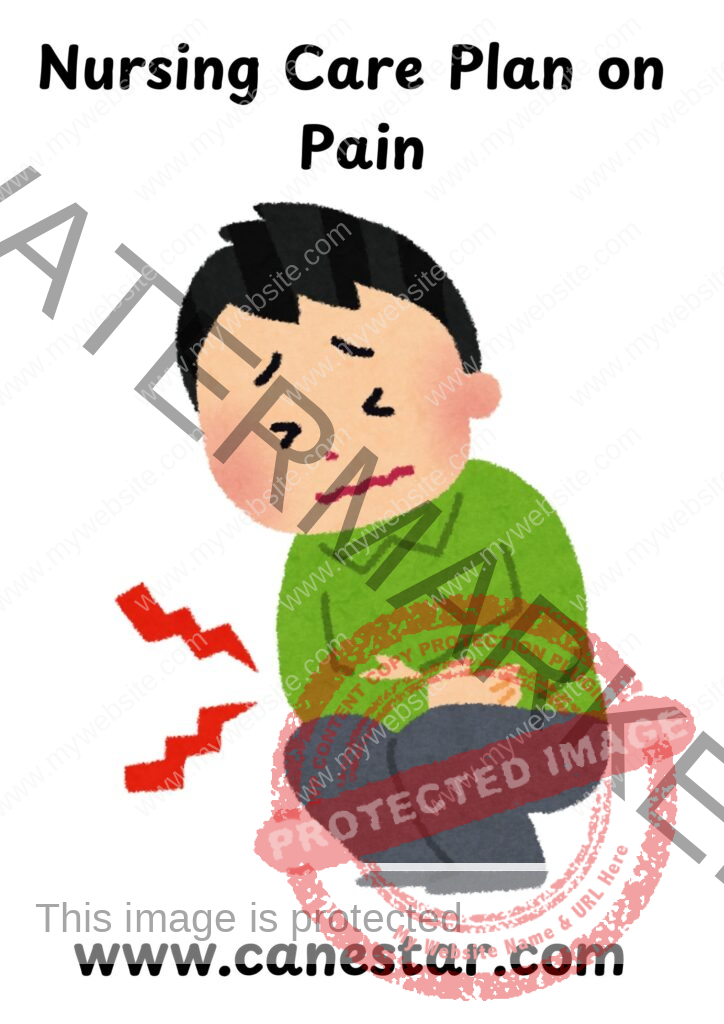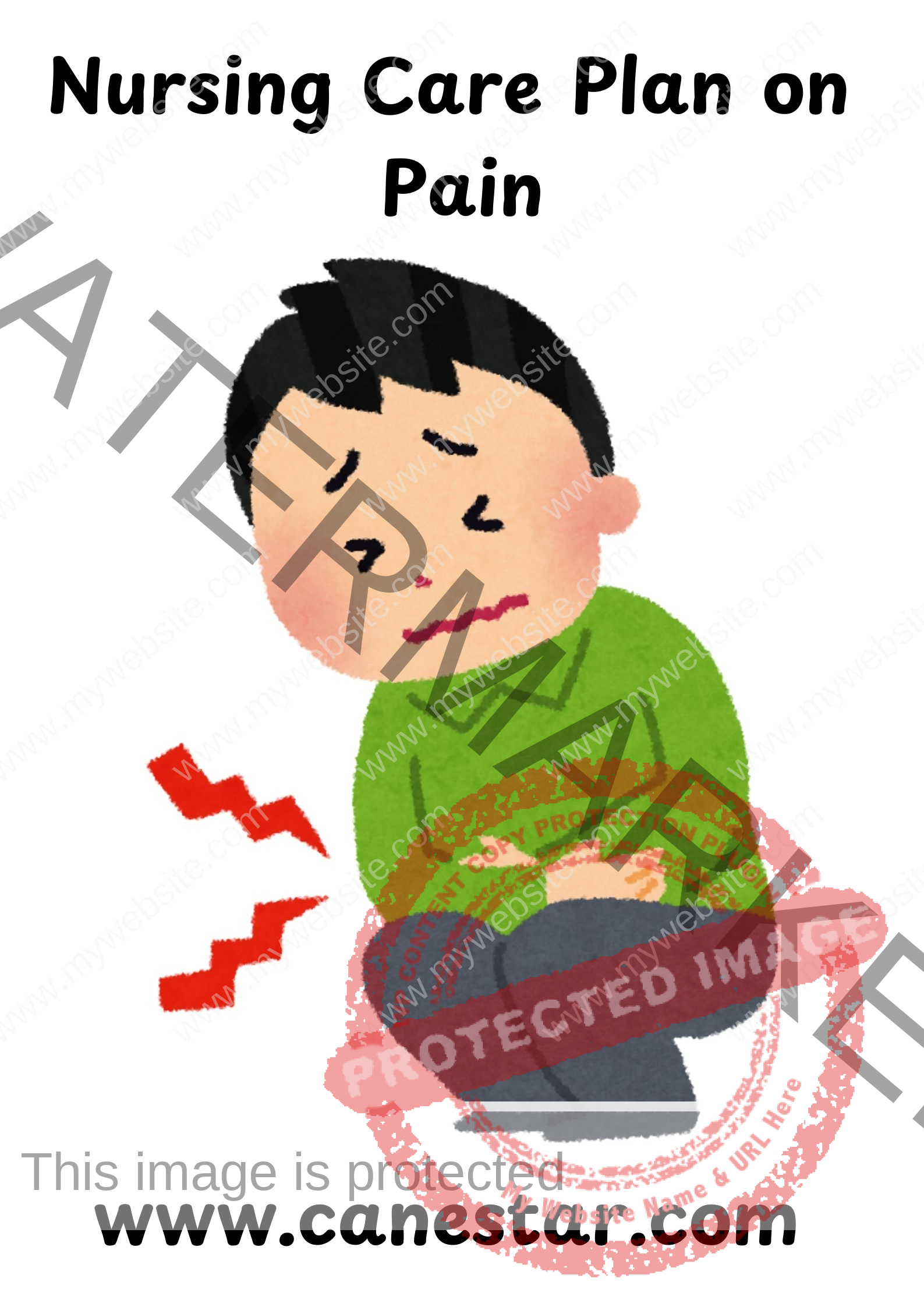NURSING CARE PLAN FOR PAIN
NURSING CARE PLAN FOR PAIN
NURSING CARE PLAN ON PAIN
Pain is an unpleasant sensory and emotional experience associated with actual or potential tissue damage. It is a subjective experience and can vary widely from one person to another. Pain serves as a protective mechanism, alerting the body to injury or disease.
Types of Pain:
Acute Pain:
- Short-term, usually associated with injury or surgery.
- Often resolves once the underlying cause is treated.
Chronic Pain:
- Long-lasting (typically more than 3 to 6 months).
- May persist even after the injury or disease has healed.
- Can interfere with daily activities and lead to psychological distress.
Nociceptive Pain:
- Caused by damage to body tissues (e.g., fractures, cuts).
- Can be somatic (affecting bones, joints, muscles) or visceral (affecting internal organs).
Neuropathic Pain:
- Results from damage to the nervous system.
- Often described as burning, shooting, or electric-shock-like.
Referred Pain:
- Pain perceived in an area distant from its source (e.g., shoulder pain from a heart attack).
Pain Assessment:
Nurses and healthcare providers assess pain using various scales to measure its intensity and characteristics. Common tools include:
- Numeric Rating Scale (NRS): Patients rate their pain on a scale of 0 (no pain) to 10 (worst pain imaginable).
- Visual Analog Scale (VAS): A line where one end represents no pain, and the other represents the worst pain, and patients mark their pain level along the line.
- Faces Pain Scale: Often used for children, this scale uses facial expressions to represent varying levels of pain.
Managing Pain:
Pharmacological Management:
- Non-opioid analgesics (e.g., acetaminophen, NSAIDs) for mild to moderate pain.
- Opioid analgesics (e.g., morphine, oxycodone) for severe pain.
- Adjuvant medications (e.g., antidepressants, anticonvulsants) for neuropathic pain.
Non-Pharmacological Interventions:
- Physical therapies (e.g., heat/cold application, massage).
- Relaxation techniques (e.g., deep breathing, meditation).
- Cognitive-behavioral therapy (CBT) to help patients cope with chronic pain.
Invasive Procedures:
- Nerve blocks, spinal cord stimulators, or surgery for pain that doesn’t respond to other treatments.
A Nursing Care Plan for Pain involves assessing the patient’s pain, identifying potential causes, setting measurable goals, and implementing interventions to alleviate or manage pain. Here is a general template:
Nursing Care Plan: Pain
Patient Information:
- Name: [Patient’s Name]
- Age: [Age]
- Diagnosis: [Medical Diagnosis or Cause of Pain]
- Date: [Date]
Nursing Diagnosis:
- Acute Pain related to [injury, surgical procedure, or medical condition] as evidenced by [patient’s verbal complaints, grimacing, increased heart rate, etc.].
Assessment Data:
Subjective Data:
- Patient reports pain at [location] on a scale of [1-10].
- Describes pain as [sharp, dull, throbbing, constant, etc.].
- Pain worsens with [movement, pressure, etc.].
Objective Data:
- Observed facial grimacing.
- Restlessness and inability to relax.
- Vital signs: increased heart rate and blood pressure.
Goal/Outcome:
- Short-term Goal: The patient will report a decrease in pain to a tolerable level (e.g., 3/10) within 30 minutes of intervention.
- Long-term Goal: The patient will demonstrate effective pain management techniques and report satisfactory pain relief before discharge.
Nursing Interventions:
Assess Pain Regularly:
- Use a validated pain scale (e.g., 0-10 Numeric Rating Scale).
- Ask the patient about the intensity, location, and characteristics of pain.
- Assess for non-verbal signs of pain (e.g., facial expressions, guarding).
Rationale: Continuous assessment helps to monitor pain levels and effectiveness of interventions.
Administer Analgesics as Prescribed:
- Administer medications (e.g., opioids, NSAIDs, or acetaminophen) per order.
- Monitor for side effects like nausea, drowsiness, and constipation.
Rationale: Medication is essential to relieve pain and improve the patient’s comfort.
Provide Non-Pharmacological Interventions:
- Apply cold or heat therapy to the painful area.
- Encourage relaxation techniques such as deep breathing or guided imagery.
- Reposition the patient for comfort and reduce pressure on painful areas.
Rationale: Non-pharmacological methods complement medication in managing pain.
Educate the Patient:
- Teach the patient about the importance of reporting pain early.
- Provide information on medication use and potential side effects.
Rationale: Patient education promotes self-management and prevents delayed pain relief.
Promote Rest and Relaxation:
- Create a quiet and comfortable environment to minimize external stressors.
- Encourage periods of rest and sleep.
Rationale: Adequate rest can improve pain tolerance and overall recovery.
Collaborate with Healthcare Providers:
- Communicate with the physician if the pain is uncontrolled with the current regimen.
- Consider alternative therapies like physical therapy or referral to a pain specialist.
Rationale: Collaboration ensures timely adjustments to the care plan if pain persists or worsens.
Evaluation:
- Short-term Outcome: The patient reported a reduction in pain to 3/10 within 30 minutes of medication administration.
- Long-term Outcome: The patient demonstrated effective use of relaxation techniques and verbalized satisfaction with the pain management plan.
Documentation:
- Date and time of pain assessment.
- Pain intensity level and characteristics.
- Interventions provided (medication, heat/cold therapy, etc.).
- Patient’s response to interventions.
- Any changes in the pain management plan.
Signature: [Nurse’s Name]
Date: [Date]


